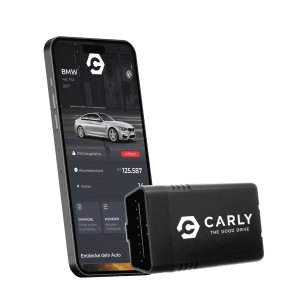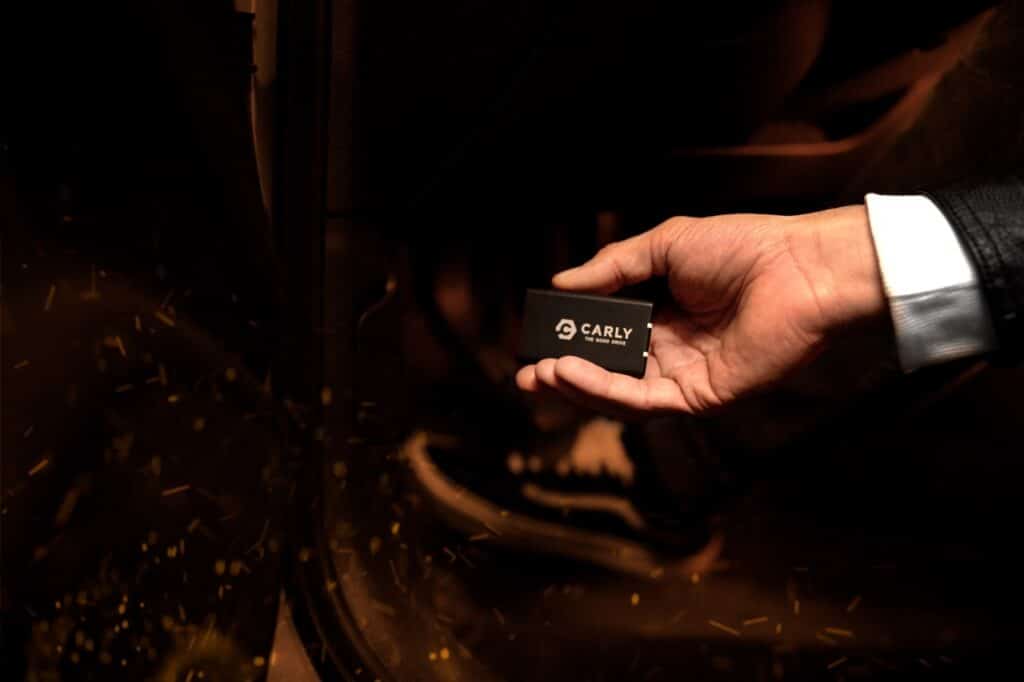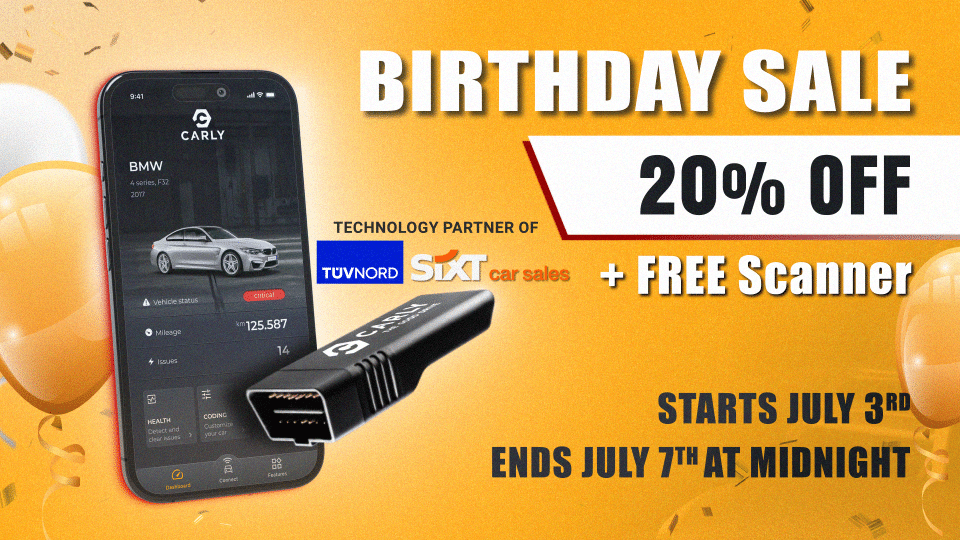Your Mercedes-Benz vehicle is your pride and joy, and naturally you want to know what’s going on with it. Maybe you have noticed a fault light and want to check the error memory, or just obtain an overall picture of your vehicle’s health. A Mercedes OBD2 scanner makes all of this and much more possible. This article will explain what OBD is, and what can be done to your Mercedes-Benz vehicle with it.
So what is OBD for Mercedes and what can you do with it? An OBD diagnostic device for Mercedes-Benz vehicles enables you to read error codes from the fault memory of your Mercedes-Benz’ complex computerized system. The fault memory contains various fault codes pertaining to different systems and areas of the vehicle. These codes indicate defects or faults in the relevant area. A distinction is made between general error codes that are the same for every make of car and manufacturer-specific codes that differ for each manufacturer. An OBD device that is specifically tailored to read Mercedes-Benz vehicles can not only read the general error codes but the manufacturer-specific ones as well. This provides a broader picture as to the overall vehicle’s health and status.
This article will explain what OBD is, what can be done with it, and the best device to use with your Mercedes-Benz vehicle.
If you’re a Mercedes-Benz owner, especially if you have models like the Mercedes-Benz Sprinter or other popular Mercedes-Benz cars, understanding the importance of a reliable diagnostic scanner is crucial. These scanners, such as the Carly OBD or the iCarsoft MB II, are designed to read trouble codes, clear codes, and offer a comprehensive view of your car’s health.

A good scan tool, which is often more advanced than standard diagnostic scanners, can access all the systems of your car, from the engine light to the transmission modules. For instance, the Star Scanner or Carly OBD is known for its ability to delve deep into complex modules, offering functionalities like live data streaming and clearing ABS and airbag codes.
The system scanner is not just for reading manufacturer specific trouble codes; it’s a diagnostic tool that provides a data stream of your car’s vital information. Whether you own a Mercedes-Benz or other car brands, a scan tool like the Youcanic scanner or a more expensive scanner can be extremely helpful. They are equipped to handle a wide range of functionalities, from reading engine trouble codes to recalibrating sensors.
What is OBD?
OBD stands for On-Board Diagnostics, which is a system integrated into the car’s control units. The control units permanently monitor themselves, recognize errors and store them in the fault memory. So the OBD system is of great use for maintaining cars.
The Emergence of OBD
In the past, each automobile manufacturer created their own standards for reading errors, known as OBD or OBD1. The origins of OBD1 in the US can be traced back to California at the end of the 1980s, as it was developed to monitor and control the levels of emissions from automobiles that were a major contributor towards pollution, particularly in car-heavy cities such as Los Angeles and San Francisco. Stricter emissions limits were introduced as well as the requirement for vehicles to self-monitor their emission control systems. Other US states adopted these regulations in the mid-1990s. While OBD1 was largely manufacturer-specific, OBD2 came into force at the turn of the 21st century aiming to offer a unified interface and protocol. All new vehicles produced since 2001 (petrol/gasoline) and 2004 (diesel) use the OBD2 standard.
The Tasks of OBD – Code Reader

The OBD records and reports all significant increases in emissions during regular operation of the vehicle, thus ensuring low exhaust emissions at all times. It continuously monitors all components relevant to emissions and protects components of the vehicle through warning of minor conditions that, if left unchecked, could cause major damage, and necessitate costly repairs. The OBD system is responsible for illuminating the engine control lamp in the instrument cluster to warn of any issues. It saves the data in the event of errors and provides an interface for reading them out.
Does My Car Require a Mercedes OBD2 Scanner?
If you’re wondering if a Mercedes OBD2 scanner will work on your three-pointed star, if it’s been made in the last 20 years, chances are it will. Since 1996, All vehicles in the USA have been equipped with OBD2. In the EU, it became mandatory for petrol (gasoline) vehicles to be equipped with it since 2001, and diesel vehicles from 2004. American vehicles with OBD2 will have a note stating ‘OBD II compliant’, whilst EU vehicles should carry at least emission class of Euro 3 in their vehicle papers.
For Mercedes-Benz owners, having a scanner that is compatible with their car is essential. The OBD II port in your Mercedes allows for a range of scanners to connect, from the simple ones for those on a tight budget to the more advanced ones like the Star Scanner or Carly OBD, which offers a comprehensive scan of all systems. While some may opt for a visit to the auto repair shop, having a diagnostic scanner at home saves money and time, providing immediate access to your car’s diagnostics.
The price of these scanners can vary, but remember, the best scanner for your Mercedes or any other car brand isn’t always the most expensive. Scanners on the market today range from simple code readers to complex diagnostic tools with wide-ranging capabilities. They can help in clearing trouble codes, resetting the check engine light, and even programming new functionalities.
Where Can I Find the Mercedes OBD2 Scanner Connection in My Car?
A Mercedes OBD2 scanner port should be sited within one metre of the driver’s seat. In most cars, the port can be found underneath the dashboard, below the steering column or between the steering column and driver’s door. It might also be between the steering column and the center console. On Mercedes-Benz vehicles, the port is usually found on the left side, between the steering column and the driver’s door. Consult your vehicle manual or the internet if unsure.
What Does the Plug Look Like?
The connector has a total of 16 pins. Pin 2 stands for J1850 Bus +, pin 4 for vehicle ground, pin 5 for signal ground. Other pins are also assigned: pin 6 with CAN high (J-2284), pin 7 with ISO 9141-2 K output, pin 10 with J1850 bus, pin 14 with CAN low (J-2284), pin 15 with ISO 9141 -2 L output and ultimately pin 16 with the battery (+) voltage. So not all pins are assigned according to OBD2/EOBD. All free pins can be assigned by the manufacturers to their preference.
How OBD Works – Code Reader Mercedes
There are two monitoring systems for OBD. Permanently monitored factors include those pertaining to exhaust gas-related systems, engine misfires, fuel injection, and lambda probe. Other systems are monitored on a driving cycle basis, such as catalytic converter or tank ventilation system. If an error occurs under two or more consecutive driving cycles, it is recorded in the fault memory and the warning light comes on. If the error no longer occurs after 40 cycles of consecutive error-free driving, the light goes out and it is cleared from the fault memory.
What Do the OBD Error Codes Stand For?
When OBD2 was standardized, each manufacturer’s individual error codes were replaced by universal error codes. The first letter indicates the area in which the error occurred. For example, “P” stands for Powertrain. The second digit can be a “0”. In the case of “1” or other digits, these are manufacturer-specific codes. The third digit indicates the assembly in which the error occurred. For example, the “4” stands for exhaust gas cleaning systems. The last two digits stand for the component and the type of error.
What Do the Different OBD Modes Stand For?
The range of functions is divided into ten different modes. “Mode 01” allows current diagnostic data to be queried. It grants access to the data values and can query and display sensor data and other parameters in real-time. Furthermore, the so-called “Readiness Code” can also be displayed via “Mode 01”. This is displayed in two rows of numbers in a twelve-digit binary code.
The first row of numbers shows what is installed in the car. Each position has its own meaning. The “0” indicates that the part is not available, a “1” means that it is available. The second row of numbers also uses 1s and 0s to indicate whether a diagnosis has been carried out (“0”) or not yet (“1”). However, no error detection is displayed. “Mode 02” allows the freeze frame data to be queried, ie those that were saved when an engine error code occurred. “Mode 03” makes the confirmed emission-relevant error codes available to the external diagnostic device. Most automakers also put their own proprietary fault codes there. “Mode 04” can use an external diagnostic device to command the control unit to delete all emission-related data. This includes all error codes including the freeze frame data and other data. Manufacturer-specific data can also be deleted in individual cases. “Mode 05” is responsible for querying the lambda probe monitoring test results. The interrogation of the systems that are not continuously monitored takes place via “Mode 06”. “Mode 07” is responsible for reading out data that failed during a work cycle but were not sufficient to generate an error code. “Mode 08” is generally not used in Europe. In contrast, “Mode 09” is responsible for accessing special vehicle information, such as the chassis number (VIN). There is also “Mode 0A”, which enables the diagnostic devices to read out all error codes with the status “permanent DTC”. The error codes are then retained in the memory of the control unit until it is determined that the error is no longer present.

What Is Stored in the Error Memory?
In modern vehicles, including those that use a Mercedes OBD2 scanner with an OBD interface, the fault memory is part of the control unit. This interface can keep records of malfunctions that can be accessed later. For this purpose, the control unit checks, for example, whether the measured values received are correct for the proper operating of the vehicle.
The errors detected during this process are stored in a non-volatile manner. Most of them use an EEPROM for this purpose. Each control unit only stores its own faults, so that there are actually many independent fault memories in the vehicle, and all must be checked for a comprehensive diagnosis.
Are All Error Codes Bad?
A common misconception is that all error codes are doom and gloom. A vehicle having an error code is not a bad thing, as long as it is properly read, and the underlying conditions understood and rectified depending on severity. Some error codes might require immediate attention, for example, while others might be random errors, or can be fixed later. Properly understanding error codes can save you panic and expensive workshop visits.
How Can You Read Out the Error Memory?
Workshops can use diagnostic devices to read fault codes from the fault memory, along with the data recorder and vehicle diagnostic system. Depending on the vehicle, all control units may be automatically checked, or individually checked manually. After errors have been read and the reasons fixed, the error memory can be cleared.
However, you no longer need to rush to a workshop each time the warning light comes on. Let us introduce you to Carly. Carly is a diagnostic app that allows you to directly read the fault memory from your smartphone. You just need to plug the Carly Universal OBD Scanner into your car’s OBD2 port, and it subsequently connects to the Carly app on your phone via Bluetooth Low Energy (BLE). With the tap of a button, all error codes are read and presented in a few minutes.
What Does It Cost to Read Out the Fault Memory?
If its at a workshop, it can easily cost €25 to €60 or more for a scan. If an error is detected and needs immediate correction, those costs can easily skyrocket. Your final bill will therefore be much higher. Authorized workshops may read the fault memory for free, with the caveat that any repairs must be undertaken at their facility. Workshops use professional-level diagnostic equipment that costs thousands of euros, which are not suitable or cost-effective for the average vehicle owner.
How much does Carly cost? The Carly Universal OBD Scanner is a one-time purchase that costs €59.90 (plus shipping). Carly requires this particular scanner, as it ensures a seamless and trouble-free experience. You can install the Carly app from the Apple or Android app stores and evaluate some of its functions. If Carly works for you, consider subscribing to the full Carly app. You can purchase a license for a single vehicle brand, or all vehicle brands and costs vary depending on your choice.
Carly for Mercedes
If you’re looking for a Mercedes OBD2 scanner, a single-brand license on Carly for Mercedes-Benz currently costs €2.42 per month and includes other features in addition to the normal functions of on-board diagnostics and error readout.
Carly also offers the Carly Used Car Check which is used to check the mileage across all on-board control units and compare, therefore providing you an invaluable tool to check whether the mileage has been tampered with on a used vehicle that you are planning to purchase. Tampered mileage vehicles are often sold, and it is estimated that up to a third of used vehicles have been tampered with. The resulting repair costs can be significant.

The Carly Health check function uses a traffic light system to show you the status of the vehicle. Following a comprehensive analysis by Carly, you will be presented with three colors. Red means your vehicle is in a bad state and must go to a workshop immediately. Yellow signifies some minor issues that you should have investigated by a workshop at a convenient time. Green means all is well, you can relax.
Conclusion
In summary, whether you own a Mercedes-Benz Sprinter or any other model, investing in a diagnostic tool like a system scanner or a more specialized Mercedes-Benz scanner can save you trips to the repair shop and give you a better understanding of your car’s health.
For many vehicle users, OBD is a mysterious thing that seemingly works through black magic. You watch the workshop employee plug in this serious-looking device and read some indecipherable codes before telling you what is wrong, what needs to be fixed, and subsequently clearing the codes.
After reading this article, you can see that it’s not so mysterious after all. With your own Mercedes OBD2 scanner, you can check and decipher the codes yourself, determine the state of your car’s systems and even check for mileage tampering — all thanks to Carly.


